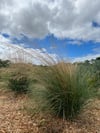Poa labillardieri - Common Tussock Grass
Common Tussock Grass (Poa labillardieri) is a versatile native Australian plant that thrives in a range of environments, from woodlands and grasslands to coastal areas, making it an adaptable and valuable addition to any garden landscape.
IUCN Conservation Status:
As of the latest assessment, Poa labillardieri is not listed on the IUCN Red List, indicating that it currently faces no significant conservation threats. This resilient species contributes to the ecological diversity and stability of its natural habitat.
Place in Local Habitat and Ecosystem Distribution:
Common Tussock Grass plays an essential role in various Australian habitats, including grasslands, open woodlands, and coastal regions. It often coexists with other grass species like Microlaena stipoides and Themeda triandra, forming intricate ecosystems that support native fauna.
Planting Companions:
In garden settings, Common Tussock Grass pairs well with other native plants such as Lomandra species, Dianella species, Grevillea and big Eucalyptus species. This combination creates a visually appealing and ecologically beneficial landscape.
Human and Wildlife Uses:
Common Tussock Grass provides valuable forage for native animals, making it a crucial component of local food webs. Its dense growth habit also offers habitat and shelter for small mammals and birds.
Care Instructions:
Plant Common Tussock Grass in well-draining soil in a sunny to partly shaded location in your garden. Regular watering during the establishment phase is essential. Once established, it requires minimal care and maintenance, making it suitable for low-maintenance landscapes.
Size, Height, Width, Flower, and Leaf Characteristics:
Common Tussock Grass forms dense clumps with tufted foliage. It typically reaches a height of 0.5 to 1 meter, and its flower spikes can extend slightly higher. The leaves are narrow and can range in color from blue-green to gray-green.
Latin Etymology:
The genus name "Poa" originates from the Greek word for grass, while the species name "labillardieri" pays tribute to the French botanist Jacques Labillardière, who contributed to the documentation of Australian flora during the 18th century.
Traditional Uses:
Common Tussock Grass holds historical significance for Indigenous Australians. Traditionally, the leaves of this grass were used to weave baskets, mats, and other practical items. This cultural use showcases the resourcefulness of Indigenous communities and their deep connection to the land. Additionally, the dense growth habit of Common Tussock Grass provides valuable forage for native animals, making it a crucial component of local food webs. Its dense clumps also offer habitat and shelter for small mammals and birds.

